Notting Hill Carnival
Notting Hill, London. Sunday 29 August 2010
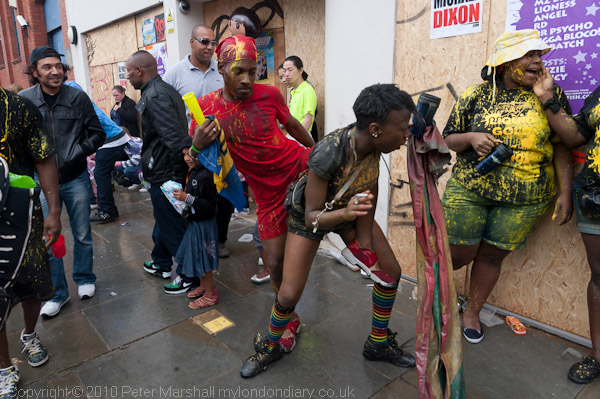
more pictures
I started going to carnival around 1990 and only missed a year since when I had a very painful knee injury. Even then I staggered down the road as far as my local railway station, before being forced to admit to myself that I really couldn't make it any further. But these days it has lost some of its earlier charm, and I've got older and less resistant to sound at decibel levels that rattle your internal organs.
Back in the old days I'd be happy with a couple of Leicalikes (perhaps a Minolta CLE and a Konica Hexar) around my neck, one with a 28mm and the other 35mm. Nowadays I don't feel photographically dressed without at least one large DSLR and two or three lenses. I don't think this is progress; perhaps time to get back to something simpler. But at least I managed to take only one DSLR and a single lens, the Sigma 24-70mm.
While I was using film, I mostly shot carnival in black and white. It helped me to concentrate on the people and not get carried away by the costumes. Digital colour is so much better that it has really made colour into a different medium, and I find it hard to give up its visual pleasures now. It seems rather artificial to shoot in colour and then convert the pictures to black and white, although I think many of these pictures would work at least as well.
I used always to go on both days, but in recent years I've only gone on
the Sunday - Childrens' Day. It has the advantage of being a little less
crowded, but there is a little less of the mayhem that can make for
exciting pictures.
more pictures
Sipson Celebrates Third Runway Victory
Sipson, Middlesex. Saturday 28 August 2010
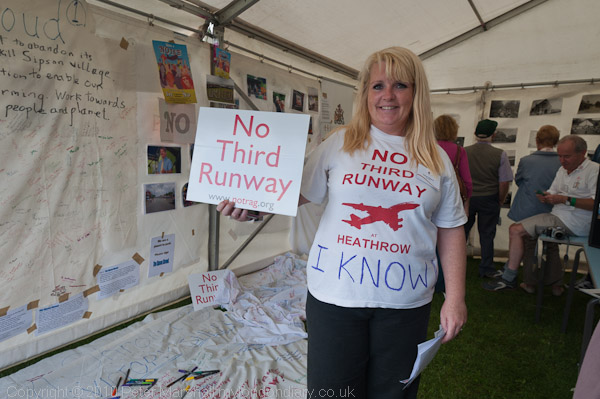
Tracey in the exhibition about the campaign
more pictures
Residents of Sipson and the neighbouring Middlesex villages of Harmondsworth and Harlington held a Family Fun Day to celebrate the successful end to their campaign against BAA's plans to create a larger airport at London Heathrow by building a new runway and destroying their villages.
BAA is a private company owned mainly by the Spanish company Ferrovial who bought it in 2006 and until 2008 when it was forced to sell London Gatwick it owned all three London airports.
In 1999 at the time of the inquiry into the building of Heathrow Terminal 5, BAA had sent out leaflets to local residents assuring them that T5 would not lead to a demand for a third runway, and the inquiry inspector had stated that in his view a third runway would be unacceptable - and according to BAA ruled out building one at their express request.
In 2002/3, BAA broke the pledge it had made to the Terminal Five (T5) inquiry not to ask for a third runway at London Heathrow when it published its BAA Heathrow Master Plan. This called for a 'short runway' but this soon grew into a demand for a full 2,500 metre length, along with cleared areas at both ends where the risk of crashes would be highest. It soon emerged that they wanted a development on a huge scale, with a sixth terminal, ground areas for standing aircraft and a relocated motorway spur that would cover most of Harlington, Sipson and Harmondsworth, as well as subjecting a further area of West London to increased aircraft noise and excessive pollution. BAA even declined to rule out making a request for a fourth major runway at Heathrow.
Local residents and environmental groups were appalled by the scale of the proposed developments when many had been calling for a reduction in traffic at Heathrow because of its environmental impact, and new groups such as NoTRAG (No Third Runway Action Group), composed of local residents joined with existing environmental groups such as HACAN ClearSkies along with most of the surrounding local authorities, led by the London Borough of Hillingdon and local MPs in a joint campaign against airport expansion. Later they were joined by other groups, including Greenpeace who bought a local orchard as their 'Airplot' and direct action campaigners such as 'Plane Stupid', 'Camp for Climate Action' and 'Climate Rush' whose actions gained important media coverage.
The first large protest march took place in June 2003 and their were many further actions, including a mass protest at Heathrow in May 2008 and many smaller events, lobbies and meetings. The local authorities and HACAN took up legal actions including a challenge to night flights in the European Court of Human Rights.
By 2008/9 the campaigners had largely won the environmental, social and economic arguments against expansion, and the Conservative Party had announced it would scrap the plans if elected. The Labour government's decision to press ahead, made early in 2009, only scraped through Parliament with the biggest rebellion on an opposition motion since Labour came to power, and in March 2009 was ruled by the High Court to be "untenable in law and common sense."
The Family Fun Day, organised by Hillingdon Council and NoTRAG on a recreation ground at the centre of the proposed development in Sipson had a variety of entertainments, including bouncy castles, miniature train rides, a waltzer and a Ferris wheel, as well as refreshments, but it was the exhibition about the campaign and the stage that held my attention. There were local youth dancers, singers and other performers, but the biggest welcome was for the three speakers.
John Stewart of HACAN ClearSkies started by describing how they had achieved what his recently released book calls a 'Victory Against All The Odds', putting "success down to three main things: the building up of what it calls the largest and most diverse coalition ever to oppose expansion of an airport in the UK; a willingness to challenge the economic case for expansion; and a determination by the campaigners to set the agenda."
In his press release Stewart stated: "The victory was no fluke. It wasn’t a question of luck. It was the result of a clear strategy, a radical approach, daring tactics and an utter refusal by the campaigners to believe that we wouldn’t win."
Stewart stressed the need to continue the campaign to ensure that airport expansion remains off the agenda and to curb noise and pollution from London's airports, and introduced Geraldine Nicholson, Chair of NoTRAG who together with a small hard-working committee had produced an impressive mobilisation of local residents - many of whom work at Heathrow - against the proposal.
Nicholson thanked all the residents and campaigners, including Greenpeace who had signed up 91,000 people as 'beneficial owners' of their nearby Airplot, and praised the work of the local authorities, particularly the local Hillingdon Council, both for the work of the officers and the support of the councillors, especially the final speaker, Cllr Ray Puddifoot who has been the Leader of the London Borough of Hillingdon since 2000.
As well as the 'Fun Day' there was also an open afternoon at the nearby Greenpeace 'Airplot' where as well as seeing the resident's allotment and a bee-keeping display we could also see the apple trees planted last November by celebrities including Poet Laureate Carol-Ann Duffy, actors Alison Steadman and Richard Briers and Liberal Democrat leader Nick Clegg and leading environmental organisations. Although David Cameron did not attend he had sponsored a tree.
The apples in the Airplot Orchard celebrate the most famous and best tasting of all apples, the Orange Pippin first grown around 1825 a mile or so away at Heathrow by Richard Cox, along with other varieties derived from this, including Feltham Beauty. Cox's grave is in the nearby churchyard at Harmondsworth.
Just around the corner from the Airplot, more fruit and vegetables are
growing at Transition Heathrow's 'Grow Heathrow' site, a long-abandoned
market garden squatted in March and now facing the threat of eviction,
with a court appearance at Uxbridge on 2 September. The community garden
is part of a wider project by Transition Heathrow to create more
sustainable and resilient Heathrow villages after the dropping of the
third runway. The group is working to build long-term infrastructure and
networks to deal with peak oil and the threat of climate change.
more pictures
CUMBRIAN INTERLUDE: Keswick
Keswick, Cumbria. August 2010
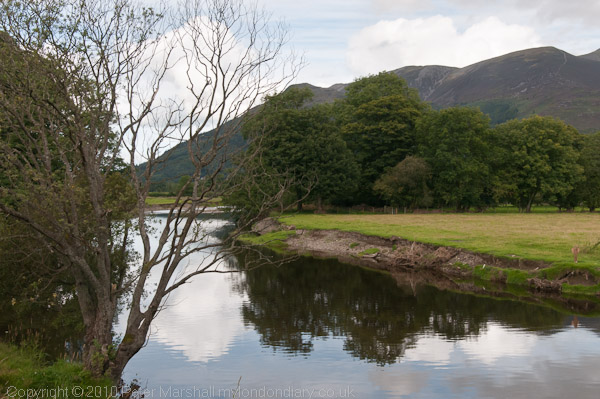
River Derwent at Keswick
more pictures
Frankly Keswick is a place to avoid. The centre is busy and full of tourist rubbish, though we did find one shop selling decent ice cream, and the vegetarian restuarant had some nice cake (and a decent bottled beer.)
We'd been dropped off at Dodd Wood, opposite Mirehouse, a few miles north, where some of our friends wanted to watch for ospreys, and walked mainly along a path called the Allerdale Ramble to Keswick. Unfortunately at one point in the wood we made the mistake of following a footpath sign that pointed to Keswick and it took us back down onto a path beside the main road for a mile or so.
Later, another sign, stressing we should keep to the footpath sent us
off along by the Derwent where we should have turned to the right, and
it was perhaps half a mile before we realised our misake and it took a
bit of wandering to find our way back to the path. Eventually, as we
came up to How Farm, that took us down to the riverside again, only to
be blocked by a barbed temporary fence across. Fortunately we could go
over a stile to the riverside for a short detour around, but a little
further on, red and white tape was stretched across to show that the
path was closed, as if anyone on reaching it would turn and walk back.
Had there been a warning half a mile earlier it could had suggested a
sensible alternative route through How Farm. We kept on, only to find
that after we went under a bridge the whole area was being dug up and
there were a couple of guys with their bulldozer taking a lunch break.
It's surprising that walking a designated path - the Allerdale Ramble -
in one of the most popular areas of the country for walkers should
present these kind of difficulties. You get the feeling the Lake
District doesn't want tourists. We were able to scramble up on the road
and make our way around to the path as it continues south past Derwent
Bridge and then cross the suspension bridge for the path into the centre
of Keswick.
more pictures
CUMBRIAN INTERLUDE: Northern Fells
Caldbeck & Hesket Newmarket etc, Cumbria. August 2010
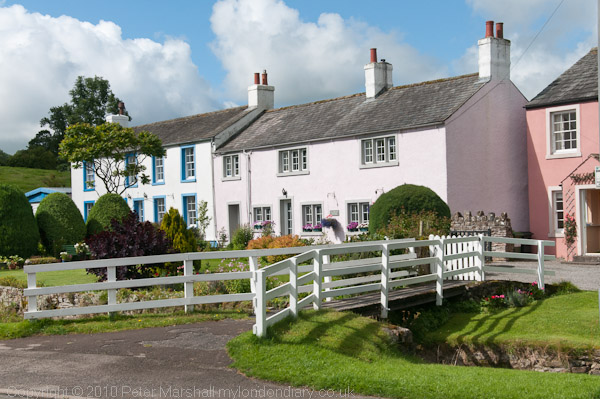
Cottages in Caldbeck
more pictures
Caldbeck is a small village in the north of the Lake District, north of Skiddaw and Blencathra, and although inside the national park is less busy and less touristy than most of the area. Probably its main claim to fame is that John Peel (not, you ken, the DJ but the man with the horn and hounds) was buried in the churchyard at St Kentigern's church. St Kentigern was an early Welsh Christian who became bishop of Glasgow and travelled around the area, leaving a well close to the church beside the Cald Beck.
The area around was from the middle ages important for its mines which produced minerals including lead, copper and barytes. The industry was at its height in the 17th century and the last mine only closed in 1960. There was also quarrying and of course farming, and the latter continues, along with the tourist trade.
It's all nicely kept and there is a decent pub serving a decent pint (Jennings) and one of the old water mills has been converted into a cafe, shops and workshops for the tourists, particularly those with expensive tastes in jewellery and knitted goods.
A couple of miles away is another well-preserved village, Hesket
Newmarket, which boasts the UK's first co-operative pub, bought by
residents to keep it open (though only in the evenings and at weekends)
and behind it a small co-operative brewery with a deservedly world-wide
reputation for its fine beers including Doris's 90th Birthday Ale, where
I enjoyed tasting a complimentary glass of another of its brews.
Several, including Doris, are available for sale there in bottles, but
unfortunately I could only carry one. As well as a number of pubs around
the Lake District, some of the beers are occasionally seen at festivals
elsewhere and can be ordered in barrel quantities on the web.
more pictures
CUMBRIAN INTERLUDE: Cumbrian Coast
Silloth, Allonby, Maryport etc, Cumbria. August 2010
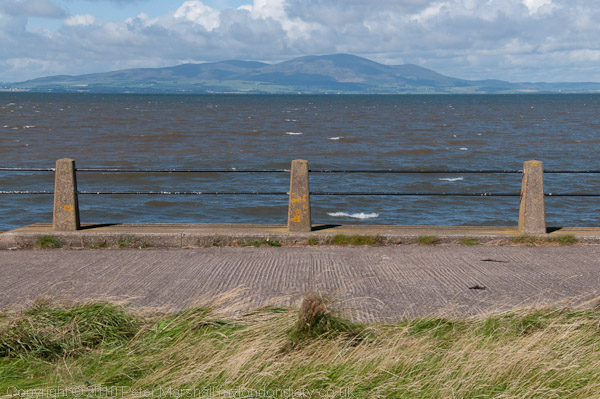 The
lumpy bit on the other side of the Solway is Scotland (Criffel is
569m)
The
lumpy bit on the other side of the Solway is Scotland (Criffel is
569m)
more pictures
I spent most of Sunday in Silloth, walking around the town. Used by the monks of Abbeytown as a harbour to export the grain they grew in the flat fields they reclaimed near the Solway, the current town was set up by the Carlisle & Silloth Bay Railway & Dock Company who saw it both as a port and as a holiday destination when then built the line linking it to Carlisle in 1856.
In the second world war Silloth airport, opened in 1939 became an important RAF training and operational base, particularly for the Lockheed Hudson used by the Coastal Command. So many of them crashed into the Solway that it became known as Hudson Bay; 61 airmen, many Canadian, are buried in a local cemetery.
The RAF base finally closed in May 1960, and the airport is largely derelict with a large car boot sale every Sunday. The railway was the first in the UK to have steam replaced by diesel in 1954 but closed following the Beeching report in September 1964.
The docks are still operating bringing in mainly dry bulk goods, including north American wheat trans-shipped at Liverpool, phosphate from North Africa, wood pulp from Spain and molasses trans-shipped in Bremen. Marshall Dock, named after the local MP who had supported it, opened in 1859, but its lock gates collapsed in a storm in 1879 and it was decided to leave it tidal and build a 'New Dock' at its landward end, which was completed in 1885 and can still handle vessels up to around 3-4000 tonnes. Carr's flour mill was built on the north side of the dock in 1886.
Later in the week I briefly visited Abbeytown, a few miles inland, where the remains of what was once the important Holme Cultram Abbey founded in 1150 by Cistercian monks from Melrose Abbey are now a parish church. The rest of the abbey buildings were used in building the village, which at one time was served by two railway lines, the Carlisle-Silloth and the Solway Junction line which was built mainly to take haematite (iron ore) from West Cumberland across the Solway Viaduct to steel works in Lanarkshire. Cheaper Spanish ore and the closure of the viaduct on safety grounds killed that line in 1921.
Allonby is a village a few miles south, which has a long history as a seaside resort and fishing village. It seemed pretty deserted when we went there, with a number of empty holiday cottages and just a few visitors, but is rather picturesque with many cottages from the seventeenth to nineteenth century and a few more imposing buildings.
From Allonby we walked south along the coastal path, stopping to look at the Roman Mile-fort 21 at CrossCanonby and the remains of the salt pans below there. Although the existing remains are from the salt works which started in 1634 and probably closed in the 1760s, salt pans along the cost existed much earlier, probably before the monks at Holme Cultram were granted the rights to them.
The Milefort was a part of the Roman defences along the edge of their Empire, which further north and east becomes Hadrian's Wall. The southern end was at Alauna, on a hill just north of modern Maryport, where we visited the site of the fort and the Roman Museum which has a fine collection of Roman altars found at the site. Geomagnetic surveys have recently revealed the site of an extensive Roman town housing perhaps 4000 people to the north of the Roman fort, itself home to 1000 men.
Maryport itself was a 'new town' created by the local landowner Humphrey Senhouse as a port from 1749 when he obtained an Act of Parliament for its development. At the centre of the new town is a large open Georgian square. The buildings in the town are largely simple but well-proportioned and it still seems a pleasant place in which to live for those who can find work. As well as a port it became an important industrial centre in the nineteenth century, particularly after the opening of the Maryport & Carlisle Railway in 1840, producing iron using local haematite iron ore and coal from mines around nearby Aspatria.
The opening of new docks at neaby Workington, along with increased iron
and steel production their made Maryport a ghost town in the 1930s, with
unemployment at over 50%. Coal mining in the area ran down and finished
n the 1960s, with a small amount of opencast mining continuing until
recently. Tourism is now the main industry, although some chemical
industry remains a little to the south on the coast.
more pictures
CUMBRIAN INTERLUDE: Around Wigton
Wigton, Cumbria. August 2010
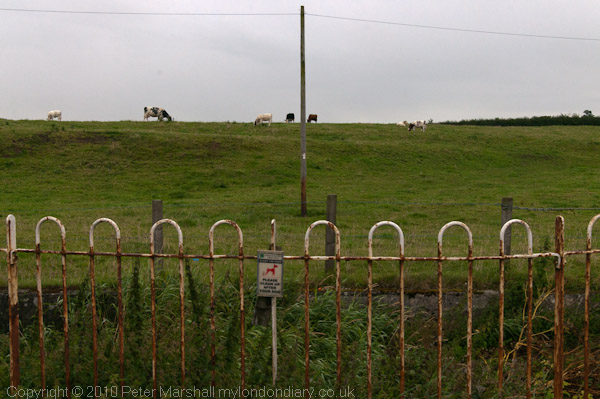
A footpath close to the centre of Wigton
more pictures
We stayed in Blaithwaite House, a Christian Centre with residential accommodation mainly used by schools and youth groups for stays with a range of 'adventure' activities. The stables there is a separate residential block which houses up to 20 people, an ideal size for our group.
The hall is around 4 miles from the centre of Wigton and a mile and a half from the nearest bus route, and feels pretty remote. The main house is attractive and in pleasant grounds with a listed summer house on an island in a small pond or lake. But most of the day we were out walking in the countryside. Perhaps fortunately in the six days we were there only one day was wet, and that day we walked into Wigton to walk around the town and back.
At the centre of Wigton is a modern factory making cellulose film and next to that a small market town full of Georgian and Victorian buildings. Although there is little notable architecture together they make a very pleasant looking place, and unlike many places now there is still a good variety of shops, including one fairly large supermarket.
Unfortunately we didn't go on market day - there is still a fairly active livestock market there which would have been interesting. The town's main attraction for tourists is as the birthplace of Labour life peer Baron Bragg of Wigton, better known as Melvyn Bragg, and the area is the scene of many of his novels. Apparently as well as his weekly Radio 4 series 'In Our Time' which has been running with only short summer breaks since 1998 he has also done stuff on TV (I wouldn't know, having not had a set where I live since I married in 1968.) Though he isn't yet stuffed and on display in the local museum, he has donated three rather good stained glass windows to the parish church, which also has some superior Victorian examples.
We also took a few short walks around the immediate area of the house
on several occasions during our stay.
more pictures
Wimbledon Chariot Festival
Wimbledon, London. 18 August 2010
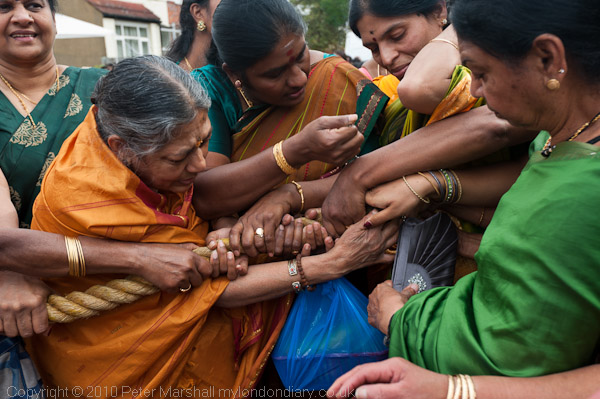
All hands to the rope to pull the chariot
more pictures
Several thousand people took part in annual procession around the local streets from the Shree Ganapathy Hindu Temple in Wimbledon. The temple was opened in 1981 in what had for some years been the Churchill Halls in Effra Road, but were built as the Anglican St Cuthbert's District Church in the 1890s. As well as housing the Shree Ghanapathy Temple, the former church hall became the Sai Mandir prayer hall.
As well as traditional temple activities for its Tamil community, the temple has a "more holistic approach to providing for the spiritual, moral and emotional needs of our devotees" with various talks, classes and health seminars. Together with the Sai Mandir it also takes part in a wide range of community projects in the London Borough of Merton and more widely, including meals on wheels, food for the homeless, and conservation work as well as welcoming local children, students, teachers and others to come and learn about Hinduism. In recent years it has also worked to support Tamil refugees from Sri Lanka.
The annual procession goes around the block of streets from the temple, with a chariot carrying one of the temple's statues of Lord Ganesha, and two other deities also being carried, I think Sri Durga (Parvati) in a smaller chariot and Sri Gayatri an a palanquin on the shoulders of eight men. Musicians played at the front of the procession and there was one adult dancer as well as a group of children.
At the start and near to the end of the procession coconuts were flung onto rocks in large woooden boxes. Many shattered but others bounced out and a few made painful contact with those standing around, and we were all covered with the coconut milk.
The large groups of men and women took hold of the ropes on the chariot and the procession began. Women carried bowls with flaming camphor, and others walked with jars on their heads. At the rear of the procession were around 15 men stripped to the waist, rolling over on the ground holding a coconut in front of them. Boys poured water on the road in front of them, and others used cloths to keep them clean and dusted them with holy ash.
Progress was slow as people came to present their baskets of fruit and coconut to the temple priests on the chariot for a blessing. The priest distributed flower petals and other gifts to them, and it took a couple of hours to cover what would have been a five or ten minute walk.
The celebrations were to continue inside the temple, and my colleague
and I who were photographing the event were invited to go in and have a
meal, but unfortunately were unable to stay.
more pictures
Finsbury to Holborn
London. Thursday 12 August 2010
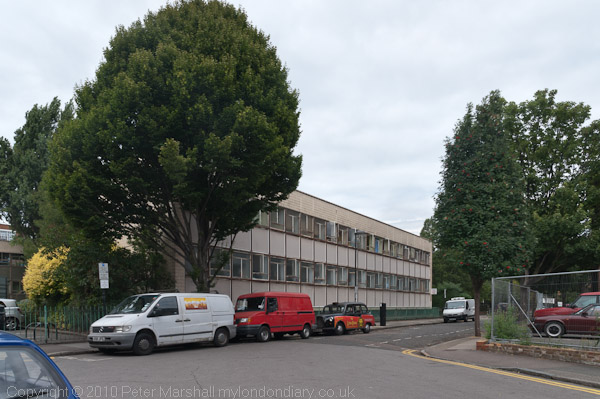 The side of the threatened Finsbury Health
Centre, one of London's key modernist buildings
The side of the threatened Finsbury Health
Centre, one of London's key modernist buildings
more pictures
I was due to meet up with some other photographers in the Princess Louise in Holborn and could have jumped on a bus, but I was early so I thought I'd walk, just aiming roughly in the right direction but not in a very straight line, taking turnings that were more interesting.
Around a hundred and thirty years ago, a young girl from mid-Wales came up to London to work at her uncle's dairy in the centre of London, either on Mount Pleasant or close to it. At that time I think they had a yard with cows, though later the milk came in by train to Paddington. My grandfather, a tradesman born in Essex, was perhaps one of her customers, or perhaps they went to the same Baptist church, but somehow they met and the rest is a part of my family's history.
But I don't think either of them would have been customers of the
Princess Louise in Holborn, a finely restored Victorian pub where I met
with a few friends, nor of Penderel's Oak a little further east where I
had a remarkably good and cheap beef madras which reminded me of my
student days long past, when Saturday night seemed to almost invariably
end (sometimes on Sunday morning) always in a curry house with a madras.
more pictures
Let Charles Stay!
Taylor House, Roseberry Ave, London. Thursday 12 August 2010
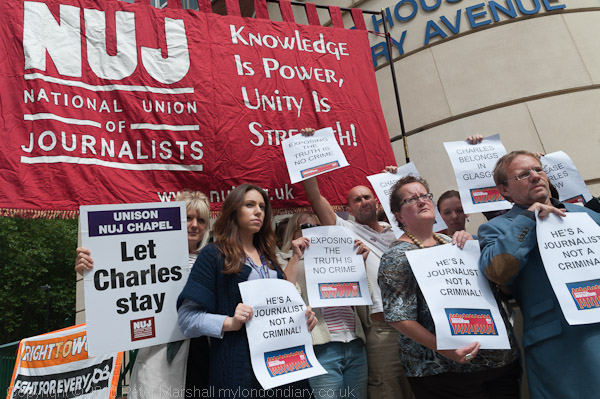
NUJ members support journalist Charles Atangana
who faces death if sent back to Cameroon
more pictures
NUJ members picketed outside the bail hearing for exiled Cameroonian journalist Charles Atangana facing deportation from the UK back to torture and probable death in his home country. Later came the good news that he had been granted six weeks bail, London, UK.12/08/2010
When investigative journalist Charles Atangana began to expose fraud and corruption in government and large corporations in Cameroon he was attacked by the government secuirty forces, beaten up and locked in jail, where he was kept under appalling conditions and subjected to torture day after day to try to get him to reveal his sources.
Finally, suffering from food poisoning and malnutrition he managed to get himself taken from jail to hospital. Unknown to his captors, he had some money sewn into his underwear which he used to bribe his way out, and then managed to flee the country and come to the UK.
In the Cameroons he had been attacked by the state-run media and faced death threats and he came to the UK believing in this country's reputation for supporting freedom of speech. For the last six years he has lived in Glasgow, where he became an active member of the NUJ branch, and although he has not been allowed to work in this country he has become a volunteer for the Citizen's Advice Bureau.
But now the death threat comes from our own government who are trying to deport him back to Cameroon, where he faces certain imprisonment and torture and probable death at the hands of the authorities. The trade union movement and the NUJ have mounted a campaign to stop his removal, and has resulted in him twice being given a temporary reprieve.
Around 30 trade unionists picked outside the Roseberry Avenue offices where a bail hearing for Atangana was being held. Atangana himself was not at the hearing but gave his evidence by a video link from the Dover immigration detention centre in which he was held, but NUJ general secretary Jeremy Dear read out a message from him thanking them for their support and expressing his wish to return to Glasgow where he has now made his home. There were also various messages of support from other trade unionists, including Brendan Barber, TUC general secretary, who has been among those urging home secretary Teresa May to release Charles and end the threat to his life.
Later the NUJ was able to announce that Atangana has been granted six weeks bail to enable him to prepare an application for Judicial Review. On the NUJ web site NUJ General Secretary, Jeremy Dear said:
"Though this is just one step in the campaign to prevent Charles' deportation back into the hands of the regime that has already imprisoned and tortured him for his brave reporting of corruption at the heart of the Cameroonian regime, it is nonetheless a tremendous victory for all the trade unionists, campaign groups, politicians and individuals who have lent their support to the campaign so far. Our thanks go out to them.
"The campaign to stop his detention will now intensify - but now with
Charles himself at the forefront of the campaign."
more pictures
Brentford
Brentford, London. 8 August 2010
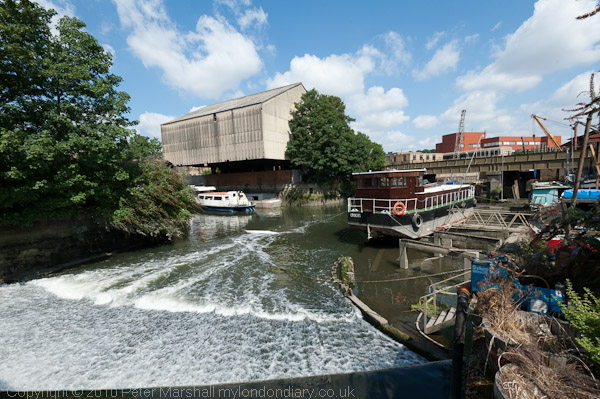
Overflow from the canal/Brent to the Thames
more pictures
Brentford used to be an important canal port at the junction of the Grand Union Canal (which is also the River Brent) with the River Thames. Commercial traffic stopped many years ago and now almost all of the British Waterways sheds have gone, replaced by blocks of flats, and the Brentford Docks is an private housing estate. But the canal and its locks are still there, along with the other small docks although rather less boat repair goes on than before.
When I grew up not far away, this was still a thriving commercial area, and public access to much of it was still fairly restricted. I photographed a little around here before much redevelopment took place, and more extensively in the 1990s. On line you can see some pictures from 2003 when some of the more recent development was starting.
Much of the walk that I took is now a part of the Thames Path, though
it isn't always well signposted, and some of the more interesting parts
are a short detour away.
more pictures
Tamil Chariot Festival in Ealing
West Ealing, London. 8 August 2010
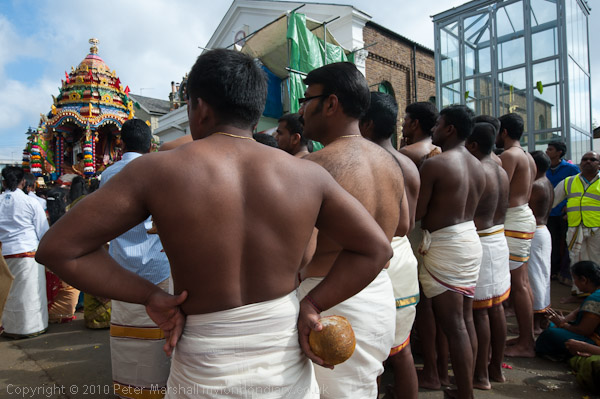
Men wait with coconuts outside the temple, ready
to roll along the road
more pictures
Several thousands attended the annual Chariot Festival from the Tamil Hindu Temple in West Ealing this morning, a colourful event in the streets around the temple. London, UK. The celebration at the Shri Kanagathurkkai Amman (Hindu) Temple in a former chapel in West Ealing comes close to the end of their Mahotsavam festival which lasts for around four weeks each year.
A representation of the temple's main goddess (Amman is Tamil for Mother) is placed on a chariot with temple priests and dragged around the streets by men and women pulling on large ropes.
Behind the chariot come around 50 men, naked from the waist up and each holding a coconut in front of them with both hands. They roll their bodies along the street for the half mile or so of the route, and behind them are a group of women who prostrate themselves to the ground every few steps. Men and women come and scatter Vibuthi (Holy Ash) on them.
The chariot, preceded by a smaller chariot, was dragged up Chapel Street to the main Uxbridge Road, where the bus lane was reserved for the procession. Once it had moved off the main road, people crowded up to the chariot, holding bowls of coconut and fruits (archanai thattu) as ritual offerings (puja) to be blessed by a temple priest.
Coconuts are a major product of the Tamil areas of India and Sri Lanka and play an important part in many Hindu rituals. Many are cut open or smashed on the ground during the festival, and at times my feet (like those taking part I was not wearing shoes) were soaked in coconut milk. As I left the festival when the procession had travelled around halfway along its route I passed a group of men bringing more sacks of them to be broken.
A few yards down the road was the rest of the procession, including a number of women with flaming bowls of camphor (it burns with a fairly cool flame and leaves no residue - but at least one steward was standing by with a dry powder fire extinguisher in case flames got out of hand) and a larger group of women carrying jugs on their head.
In front of them were a number of male dancers, some with elaborate tiered towers above their heads. Others had heavy wooden frames decorated with flowers and peacock feathers, representing the weight of the sins of the world that the gods have to carry; they were held by ropes by another man, and the ropes were attached to their backs by a handful of large hooks through their flesh, many turned and twisted violently as if to escape.
The proceeds from the sale in the temple of the 'archani thattu' on the
festival day go to the various educational projects for children that
the temple sponsors in northern Sri Lanka, devastated by the civil war
there. The temple also supports other charitable projects in Sri Lanka,
and in the last ten years has sent more the £1.3 million to them.
more pictures
Twickenham, Pirates & Eel Pie Island
Twickenham, Middlesex, London. Sunday 1 Aug 2010
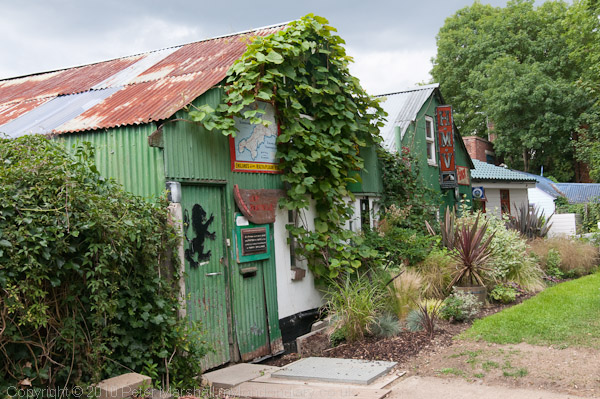
Lion Boathouse, Eel Pie Island
more pictures
I'll spare you the baby pictures. We'd gone to Twickenham to meet my
son along with his wife and very small offspring (and at two and a half
months she has already been springing on her surprisingly strong legs
for six months or more.) We met them in Marble Hill Park and walked back
to Eel Pie Island where the granddaughter appreciation society was
meeting. But on the way to the park we met some pirates. As you do in
Twickenham.
more pictures
All pictures on this section of the site are Copyright © Peter Marshall 2010; to buy prints or for permission to reproduce pictures or to comment on this site, or for any other questions, contact me.

